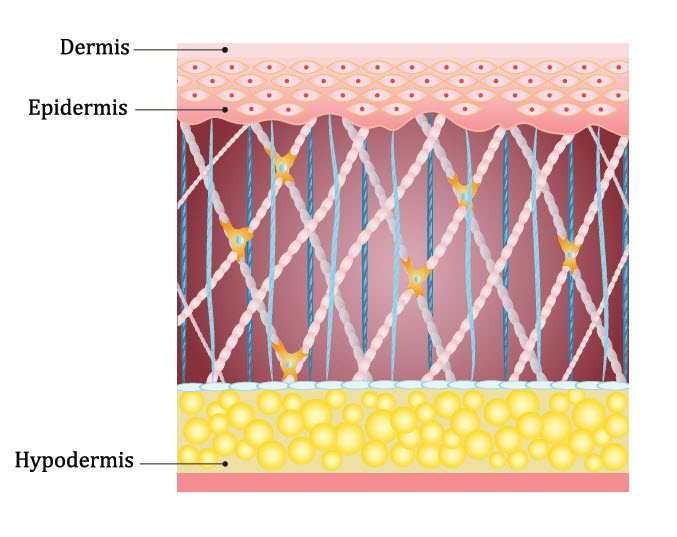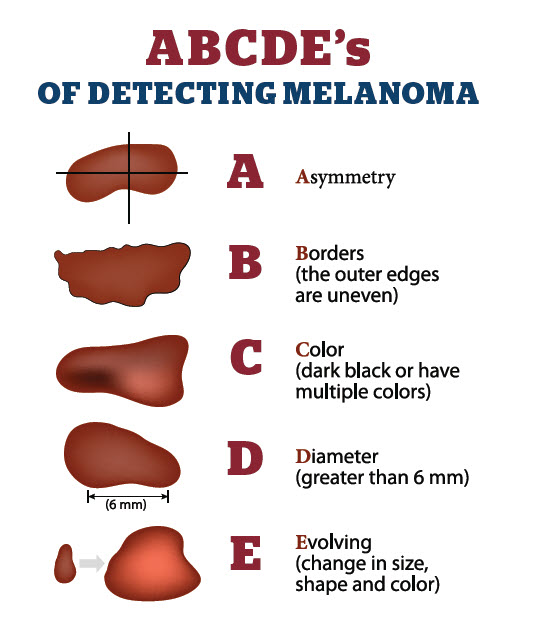control our body temperature.
There are normal changes the skin may undergo as a person ages, and there are common discolorations and growths that may impact the skin over a lifetime. Exposure to ultraviolet light
can make the skin at risk for developing skin cancer. You and your doctor play an important role in supporting your skin’s health.
Skin Layers

The skin has three layers:
- Dermis: Outermost layer. Our first line of protection against germs, heat and cold. Creates new skin cells, and cells in this layer give the skin its color.
- Epidermis: Middle layer. Contains elastin and collagen, which give skin elasticity and strength. Blood vessels and oil glands in this layer keep your epidermis soft.
- Hypodermis: Innermost layer. Contains tissue mainly made up of fat. Protects the inner organs, muscles and bones, and connects the skin to the body.
Common Skin Growths and Discolorations
- Some skin growths and discolorations are common over time.
- Age spots (sun spots/liver spots): Noncancerous dark spots. Flat and vary in size. Most common on skin that get sunlight. Do not require treatment, although a doctor can lighten or remove them.
- Skin tags: Small, noncancerous pieces of skin that hang from the body. Commonly found in areas where skin has friction. Can be removed by a doctor.
- Seborrheic keratoses: Brown, black or light tan, noncancerous wart-like growths. Texture may be scaly or waxy; size may vary; may be flat or slightly raised. Can be removed by a doctor.
- Moles: Common skin growth. Usually oval or round. Color can vary from light brown to black; may be smooth, wrinkled, flat or raised. Most do not require treatment, unless it has characteristics that may indicate cancer.
Skin Cancer
Skin cancer mainly develops on areas of skin frequently exposed to the sun, although it can occur in areas that get little or no sun. When found early, skin cancer is considered highly curable. The most common types of skin cancer are basal cell carcinoma, squamous cell carcinoma and melanoma.
Monitor for Melanoma
Melanoma is a serious form of skin cancer. A good way to help determine if something may be a elanoma is to use the ABCDE guide. Talk to your doctor about a skin growth or discoloration that meets any of these criteria.

Help Reduce Your Risk – Be Safe in the Sun
- Even on cloudy days, wear sunscreen SPF 30 or higher that protects against both UVA and UVB rays.
- Wear protective clothing such as a hat, sunglasses, long-sleeve shirt and pants when outside.
- Avoid being outside from 10 a.m. to 4 p.m., when the sun’s rays are strongest.
- Some medications may cause your skin to be sun-sensitive. Talk with your doctor or pharmacist.
Working Together With Your Doctor
Some skin changes are unavoidable, but you play an important part in taking care of your skin. Protecting your skin from the sun and other ultraviolet light sources is essential for preventing skin cancer and other issues. It is also important to perform monthly self-exams to check for anything unusual. Because the chance of developing skin cancer increase with age, meet with your doctor to have a skin exam each year. You should also see your doctor if a skin growth changes, itches or bleeds, or if you have a new growth.









